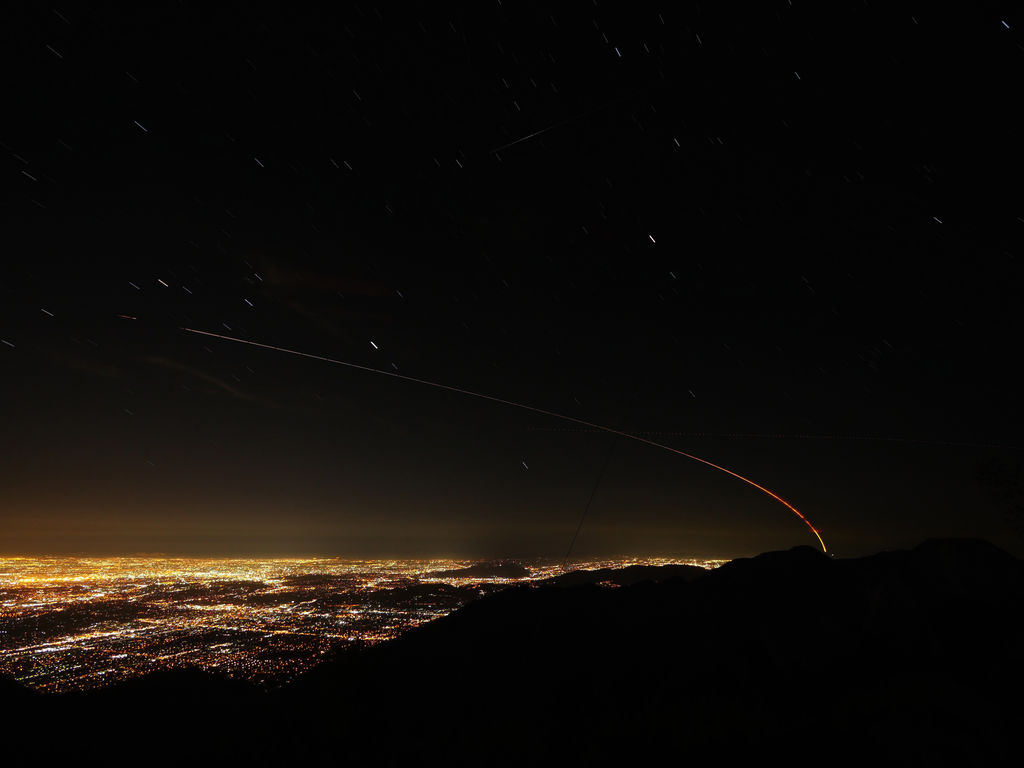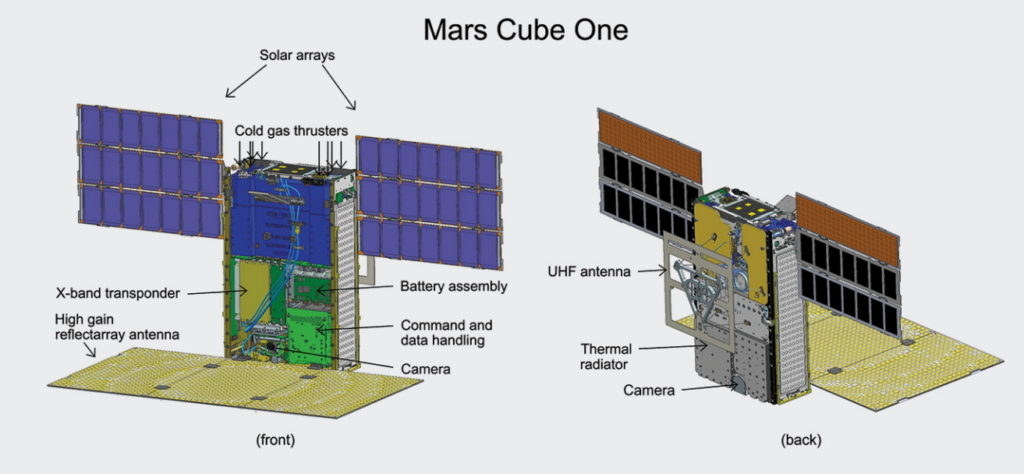Mars, the fourth rocky planet in our Solar System. It is all red and still has many secrets. However, it could teach us a lot about the formation of other major rocky bodies like Earth or Venus. That’s why scientists are constantly sending missions to the Red Planet. On Saturday, May 5th, a new probe set off to meet Mars. This probe, or rather this lander, is Mars InSight.

Mars InSight
This lander was designed and built by NASA (National Aeronautics and Space Administration). It is very different from the agency’s previous missions, especially in the following six points:
- InSight is the first mission to explore the depths of Mars.
- InSight will provide valuable insights into the interiors of planets like ours.
- InSight will attempt, for the first time, to detect “Marsquakes.”
- InSight is the first American interplanetary mission to launch from the West Coast of the United States.
- InSight will shed light on the formation of Martian volcanoes.
- InSight will harness the time-traveling potential of the Red Planet.
InSight, far from being a name without history, is an acronym for Interior Exploration using Seismic Investigations, Geodesy, and Heat Transfer. Additionally, in English, the word “insight” means “to see the true nature of something”.
Like any object intended to land safely on Mars, InSight is enclosed in a protective shell to shield it during entry into the atmosphere. Landing on Mars is challenging due to its very thin atmosphere. Unlike Earth, it is impractical to land on Mars using only parachutes because the aerodynamic braking would be insufficient. However, unlike the Moon, the Red Planet has an atmosphere that necessitates thermal protection for landing spacecraft or rovers. Finding the right balance between these factors requires specific technological solutions.

In addition to this protection, InSight also includes a cruise stage module that ensures the lander reaches its destination. During the journey, slight disturbances such as solar flares, close encounters with comets, or spacecraft malfunctions could potentially deviate it from its intended path. The cruise stage module is equipped with small control thrusters and solar panels to power all the necessary systems for the vehicle’s survival.
In total, Mars InSight, its aeroshell, and the cruise stage module measure 1.76 meters in height, 2.64 meters in diameter, and 3.4 meters in wingspan, including the solar panels of the cruise stage module. However, this assembly is relatively lightweight, with a mass of only 694 kg at launch, distributed as follows: 358 kg for the lander itself, 189 kg for the aeroshell, 79 kg for the cruise stage module, and 67 kg for propellants. There is, however, a 27 kg difference compared to the launched payload mass, which we will address later.

Out of the 358 kg of InSight, only 50 kg are dedicated to scientific experiments. The rest is part of the lander’s structure or essential components for the proper functioning of these experiments. These components include the circular solar panels that provide the spacecraft with an electrical power output of 600 to 700 watts on sunny days on Mars, which would be just enough to power a blender. On dustier days (such as during a dust storm), the panels would provide only 200-300 watts.
The Mars InSight program had a total cost of $813.8 million for the United States, with $163.4 million allocated for the launch. On the other hand, France and Germany, which developed two experiments for the lander, invested $180 million.
Launch
The lander successfully lifted off at 13:05 on May 5th from Launch Complex 13 at Vandenberg Air Force Base in California. The launch window for this mission opened on May 5th and closed on June 8th, with two-hour windows each day. An Atlas V 401 rocket was used for this mission. The number 401 carries the following information:
- 4 indicates a 4-meter payload fairing (although there is also a 5-meter version available).
- 0 means that there are no solid rocket boosters attached to the first stage (although there can be up to 5).
- 1 specifies that the Centaur upper stage is equipped with a single RL-10 engine from Aerojet Rocketdyne (there is a version of the Centaur with 2 engines)

Indeed, launching from the West Coast of the United States, specifically Vandenberg Air Force Base in California, had logistical reasons. Typically, it’s more fuel-efficient to launch from the East Coast because rockets can take advantage of the Earth’s rotation by launching eastward over the Atlantic Ocean. However, Vandenberg offered more available launch slots on the schedule compared to Cape Canaveral. As a result, NASA chose to launch InSight from the West Coast and then adjust its trajectory into a near-polar orbit before heading to Mars.
The Atlas V rocket has a history of successful interplanetary missions. It has been used to send various spacecraft to Mars, including NASA’s Mars Reconnaissance Orbiter in 2005, the Curiosity rover in 2011, and the MAVEN orbiter in 2013. Additionally, the New Horizons, Juno, and OSIRIS-REx missions were also launched aboard the Atlas V for missions to Pluto, Jupiter, and the asteroid Bennu, respectively.
Cruise Voyage
Mars InSight will now travel through interplanetary space until it reaches its destination on November 26th. During this extended cruise phase, a total of six trajectory corrections will be performed to ensure that the probe arrives at the correct time and location on the Red Planet. These corrections are scheduled for May 15th, July 28th, October 12th, November 11th, November 18th, and November 25th.

During this long journey, InSight will communicate with Earth using NASA’s Deep Space Network (DSN). The DSN is a network of antennas located in California, Spain, and Australia. The European Space Agency (ESA) has also provided assistance to NASA by allowing the use of some of its antennas in Argentina and Australia.

The main activities during this cruise phase will include calibrating the lander’s equipment and making adjustments to the probe’s orientation so that the solar panels face the Sun and the antenna points towards Earth. Unlike some other Martian probes, InSight will not be in constant rotation during the journey. Instead, it uses an inertial reference unit, a star tracker, and solar sensors to determine its attitude. Four thrusters are then responsible for attitude control. These four thrusters, along with the four propulsion thrusters used for trajectory corrections, are located on the lander and have extension tubes that protrude outside the atmospheric entry shell.
EDL Phase
The EDL phase represents the final phase of InSight’s flight. EDL stands for Entry, Descent, and Landing. The trajectory has been planned in such a way that the launch date does not affect the EDL date. Regardless of the launch day, the landing will take place on November 26. As you can see below, InSight will initially use only its heat shield to slow down. During this phase, the deceleration will be a maximum of 75.5 m/s², equivalent to 7.4G. Once the speed is sufficiently reduced, a supersonic parachute will be deployed. This will allow the lander to slow down further. The heat shield can then be jettisoned, and InSight will detach from the shell and use twelve retro-rockets to land at 2.5 m/s on the Martian surface.

The EDL phase for InSight is very similar to that of the Phoenix lander launched in 2008. The differences between the two missions can be summarized as follows:
- InSight will enter the atmosphere at a higher velocity: 5.9 km/s versus 5.6 km/s.
- InSight will have more mass at the time of entry: 608 kg compared to 573 kg.
- InSight will land 1.5 km higher than Phoenix, which leaves it with less atmosphere for braking.
- InSight will land during a Martian season more conducive to the formation of dust storms.
However, InSight has undergone some modifications based on the experience gained with Phoenix. These include a thicker heat shield to withstand potential dust storms, a parachute that will open at a higher speed, and stronger parachute cords.
During the EDL phase, InSight will communicate with the Mars Reconnaissance Orbiter, which will relay data to Earth using the DSN. The CubeSats MarCO A and B, launched along with InSight, will also serve as technology demonstrators by attempting to relay this data. We will discuss them further later on, as they are significant.
InSight is expected to land in the western part of Elysium Planitia, at coordinates 4.5°N 135.9°E. The landing area is an ellipse measuring 130 km long and 27 km wide. The lander has a 99% chance of landing within this ellipse. This site was chosen from among 21 other ellipses based on scientific and technical criteria to maximize the mission’s chances of a successful landing.


Experiments
A bord d’InSight, there are four main experiments: SEIS, HP3, RISE, and APSS. These experiments will provide valuable insights into Mars and, indirectly, our own blue planet.

SEIS: The Seismic Experiment for Interior Structure is a seismograph consisting of six sensors of two different types. Each group of three sensors will be arranged on a different axis to detect seismic waves from any direction. The first type of sensors will be placed in a vacuum environment and will be used to measure low-frequency waves (from a few Hertz to one hundredth of a Hertz). The other sensors will measure higher frequencies (up to 50Hz).

SEIS will be placed directly on the surface of Mars by the robotic arm carried by Mars InSight: this arm will, in fact, be the first robotic arm used on another body other than Earth. Once the sensors are placed on the ground, the arm will add a protective cover resembling a sort of bell to limit the impact of heat and wind.
This experiment will measure “Marsquakes,” a reference to Earthquakes for seismic events on Earth. However, SEIS seismographs will also be able to detect the gravitational influence of the moon Phobos as well as meteorite impacts: scientists expect to record between a dozen and a hundred.
It was the CNES (Centre National d’Études Spatiales) that led the development of SEIS, but teams from around the world participated in its construction.
HP3 The Heat Flow and Physical Properties Probe consists of two main components: a drill that will dig a hole 5 meters deep and a thermal probe that will measure heat flow changes. This will provide us with data on the amount of heat escaping from the planet’s interior for the first time.

This escaping heat is crucial as it allows geologists to determine the planet’s internal composition and its mode of operation. For Mars, this data would enable us to develop a more precise understanding of the evolution of the red planet over time.
HP3‘s drill is equipped with a mechanism that will strike the ground repeatedly to penetrate it. To do this, a block of tungsten is placed at the end of a spring, and it will take up to 20,000 strikes and 40 days to reach a depth of 5 meters. Above this mechanism, there are several thermal sensors to measure temperature at different depths as well as the thermal conductivity of Martian rocks.
Like SEIS, HP3 will be placed on the Martian surface by InSight’s robotic arm. The drill will take a 4-day break every 15 cm of drilling to prevent overheating of the mechanisms.
DLR (Deutsches Zentrum für Luft und Raumfahrt or German Aerospace Center) developed and built this instrument. The project leader, Tilman Spohn, drew strong inspiration from one of the tools placed on the Philae lander (on which he worked) to create HP3.
RISE, which stands for Rotation and Interior Structure Experiment, aims to measure perturbations in the tilt of Mars’ rotation axis. To do this, no special equipment is needed; RISE will simply use the radio signal for communication with Earth to perform its measurements.
There are two types of perturbations: precession and nutation. Precession can be easily demonstrated with a spinning top. When the top starts to lean, its rotation axis rotates around the point of contact. For Mars, this phenomenon takes about 165,000 years.
The phenomenon that RISE seeks to measure is nutation. A good analogy for nutation is checking if an egg is cooked or not by spinning it. If the center is solid, the rotation is not disturbed; if the center is liquid, disturbances are observed. For Mars, these nutations take about a year and will be measurable by RISE. To measure them, one only needs to observe InSight’s motion, and based on that, nutations can be deduced.
From these data, we can refine our estimates of the size and density of Mars’ core. To make them even more precise, a longer mission would be required. However, experiments like these cannot be entrusted to rovers because their continuous movement would not allow for nutation measurements.
From these data, we can refine our estimates of the size and density of Mars’ core. To make them even more precise, a longer mission would be required. However, experiments like these cannot be entrusted to rovers because their continuous movement would not allow for nutation measurements.
APSS, which stands for Auxiliary Payload Sensor Subsystem, is the final experiment carried by InSight and consists of a collection of sensors that will study the Martian environment. This study will cover aspects from the local magnetic field (as Mars lacks a global magnetic field like Earth but has local fields) to winds, temperature, and pressure.
The primary reason for installing APSS is to determine whether the data from the SEIS seismograph are influenced by the magnetic field or the winds. However, APSS will also serve as a valuable experiment to improve our understanding of the Martian environment.
InSight’s magnetometer will be the very first instrument of its kind to be placed on Mars. This instrument will provide insights into variations in local magnetic fields, such as whether they are altered by interactions between solar winds and Mars’ ionosphere. It will also measure the effects on the metallic core of these fields, providing further insights into Mars’ core.
The University of California provided this magnetometer, as it had done for other NASA missions, such as Galileo.
The TWINS instruments (Temperature and Winds for InSight) will measure temperature, wind direction, and wind speed. To do this, extendable arms will deploy on both sides of the lander, each equipped with a thermometer and an instrument capable of measuring air movement in three directions.
The Center for Astrobiology in Madrid proposed these instruments, and NASA used spare parts from a weather station on the Curiosity rover to create TWINS.
Since the lander will be positioned in the northern hemisphere, the SEIS and HP3 instruments will be placed to the south of it to ensure they are never in its shadow. This is also the area that will be the primary focus of Mars InSight’s cameras.
Mars InSight will also place reflectors on the Martian surface called LaRRI. These reflectors are only 5 cm in diameter and are equipped with groups of three mirrors placed at right angles. These mirror groups allow the reflection of a laser in the direction from which it came. The Italian Space Agency provided these reflectors so that they can be used by a future Martian mission to land very precisely using a laser altimeter.

MarCO
The Centaur stage of the Atlas V rocket also carried two small CubeSats, MarCO A and B (Mars Cube One), which were built and developed by JPL (Jet Propulsion Laboratory). However, the teams involved in their development prefer to refer to them as Eve and Wall-E, naming them after characters from the Pixar animated film. These two small satellites are 6U CubeSats, measuring 30cm x 20cm x 10cm, and their primary goal is to demonstrate the feasibility of establishing a relay network using CubeSats.

To test this, MarCO A and B were launched alongside InSight, and they are expected to serve as relays during the Entry, Descent, and Landing (EDL) phase. The lander will communicate with these CubeSats in the UHF band, and they will relay the data to Earth in the X band. In doing so, these CubeSats also become the first to leave Earth’s orbit!




